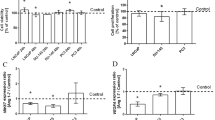Abstract
Background: Mortality from colon cancer is significant with an expected 30,350 colon cancer deaths in 2005 with current treatment(s). Long-acting natriuretic peptide, vessel dilator, kaliuretic peptide, and atrial natriuretic peptide have significant anticancer effects in breast and pancreatic adenocarcinomas.
Aim of Study: Whether these peptide hormones have anticancer effects in colon adenocarcinoma cells and whether these effects are specifically mediated by cyclic GMP has not been determined.
Methods: These peptide hormones were evaluated for anticancer effects in human colon adenocarcinoma cells and to determine whether their anticancer effects are specifically mediated by cyclic GMP.
Results: There was a 89–97% decrease (p<0.001 for each) in colon adenocarcinoma cells within 24 h with 1 mM of these peptide hormones. There was a significant (p<0.05) decrease in human colon cancer cell number with each 10-fold increase in concentration from 1 to 1000 µM (i.e., 1 mM) of these four peptide hormones without any proliferation in the 3 d following this decrease. These same hormones decreased DNA synthesis 65–83% (p<0.001). Cyclic GMP antibody inhibited 75–80% of these peptides’ ability to decrease colon adenocarcinoma cell number and inhibited 92–96% of their DNA synthesis effects and 97% of cyclic GMP’s effects. Western blots revealed that for the first time natriuretic peptide receptors (NPR) A and C were present in colon adenocarcinoma cells.
Conclusions: Four peptide hormones eliminate up to 97% of colon cancer cells within 24 h with their DNA effects specifically mediated by cyclic GMP.
Similar content being viewed by others
References
Jemal A, Murray T, Ward E, et al. Cancer statistics, 2005. CA Cancer J Clin 2005; 55:10–30.
Bresalier RS. Malignant neoplasms of the large intestine, in Gastrointestinal and Liver Disease: Pathophysiology/Diagnosis/Management. 7th Ed., vol. 2. (Feldman M, Friedman LS, Sleisenger MH, eds.) Saunders, Philadelphia, PA, 2002; pp. 2215–2261.
Vesely BA, McAfee Q, Gower WR Jr, Vesely DL. Four peptides decrease the number of human pancreatic adenocarcinoma cells. Eur J Clin Invest 2003;33:998–1005.
Vesely DL, Clark LC, Garces AH, McAfee QW, Soto J, Gower WR Jr. Novel therapeutic approach for cancer using four cardiovascular hormones. Eur J Clin Invest 2004;34:674–682.
Vesely BA, Song S, Sanchez-Ramos J, et al. Four peptide hormones decrease the number of human breast adenocarcinoma cells. Eur J Clin Invest 2005;35:60–69.
Vesely DL. Atrial natriuretic peptide prohormone gene expression: hormones and diseases that upregulate its expression. IUBMB Life 2002;53:153–159.
Vesely DL, Norris JS, Walters JM, Jespersen RR, Baeyens DA. Atrial natriuretic prohormone peptides 1–30, 31–67 and 79–98 vasodilate the aorta. Biochem Biophys Res Communv 1987;148:1540–1548.
Martin DR, Pevahouse JB, Trigg DJ, Vesely DL, Buerkert J E. Three peptides from the ANF prohormone NH2-terminus are natriuretic and/or kaliuretic. Am J Physiol 1990;258:F1401–1408.
Gunning ME, Brady HR, Otuechere G, Brenner BM, Ziedel ML. Atrial natriuretic peptide (31–67) inhibits Na transport in rabbit inner medullary collecting duct cells: Role of prostaglandin E2. J Clin Invest 1992;89:1411–1417.
Dietz JR, Scott DY, Landon CS, Nazian SJ. Evidence supporting a physiological role for proANP (1–30) in the regulation of renal excretion. Am J Physiol 2001;280:R1510-R1517.
Vesely DL, Douglass MA, Dietz JR, et al. Three peptides from the atrial natriuretic factor prohormone amino terminus lower blood pressure and produce diuresis, natriuresis and/or kaliuresis in humans. Circulation 1994;90:1129–1140.
Vesely DL, Douglass MA, Dietz JR, et al. Negative feedback of atrial natriuretic peptides. J Clin Endocrinol Metab 1994;78:1128–1134.
Vesely DL, Dietz JR, Parks JR, et al. Vessel dilator enhances sodium and water excretion and has beneficial hemodynamic effects in persons with congestive heart failure. Circulation 1998;98:323–329.
Vesely DL. Natriuretic peptides and acute renal failure. Am J Physiol 2003;285:F167-F177.
Winters CJ, Sallman AL, Baker BJ, Meadows J, Rico DM, Vesely DL. The N-terminus and a 4000 molecular weight peptide from the mid portion of the N-terminus of the atrial natriuretic factor prohormone each circulate in humans and increase in congestive heart failure. Circulation 1989;80:438–449.
Hunter EFM, Kelly PA, Prowse C, Woods FJ, Lowry PJ. Analysis of peptides derived from pro atrial natriuretic peptide that circulate in man and increase in heart disease. Scan J Clin Lab Invest 1998;58:205–216.
Franz M, Woloszczuk W, Horl WH. Plasma concentration and urinary excretion of N-terminal proatrial natriuretic peptides in patients with kidney diseases. Kidney Int 2001;59:1928–1934.
Dexter DL, Barbosa JA, Calabresi P. N, N-Dimethyl-foramide-induced alteration of cell culture characteristics and loss of tumorigenicity in cultured human colon carcinoma cells. Cancer Res 1979;39:1020–1025.
Vesely DL. Signal transduction: Activation of the guanylate cyclase-cyclic guanosine-3′5′ monophosphate system by hormones and free radicals. Am J Med Sci 1997;314:311–323.
Vesely BA, Fitz SR, Gower WR Jr, Vesely DL. Vessel dilator: Most potent of the atrial natriuretic peptides in decreasing the number and DNA synthesis of squamous lung cancer cells. Cancer Lett 2006;232:226–231.
Vesely BA, Song S, Sanchez-Ramos J, et al. Five cardiac hormones decrease the number of human small-cell cancer cells. Eur J Clin Invest 2005;35:388–398.
Saba SR, Garces AH, Clark LC, Soto J, Gower WR, Jr, Vesely DL. Immunocytochemical localization of atrial natriuretic peptide, vessel dilator, long acting natriuretic peptide and kaliuretic peptide in human pancreatic adenocarcinomas. J Histochem Cytochem 2005; 53:989–995.
Mohapatra SS, Lockey RF, Vesely DL, Gower WR, Jr. Natriuretic peptides and genesis of asthma: An emerging paradigm? J Allergy Clinical Immunol 2004; 114:520–526.
Suga SI, Nakao K, Hosoda K, et al. Receptor selectivity of natriuretic peptide family, atrial natriuretic peptide, brain natriuretic peptide, and C-type natriuretic peptide. Endocrinology 1992;130:229–239.
Author information
Authors and Affiliations
Corresponding author
Rights and permissions
About this article
Cite this article
Gower, W.R., Vesely, B.A., Alli, A.A. et al. Four peptides decrease human colon adenocarcinoma cell number and DNA synthesis via cyclic GMP. Int J Gastrointest Canc 36, 77–87 (2005). https://doi.org/10.1385/IJGC:36:2:77
Issue Date:
DOI: https://doi.org/10.1385/IJGC:36:2:77




